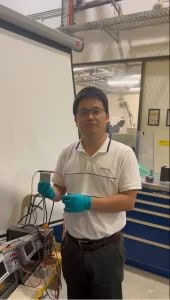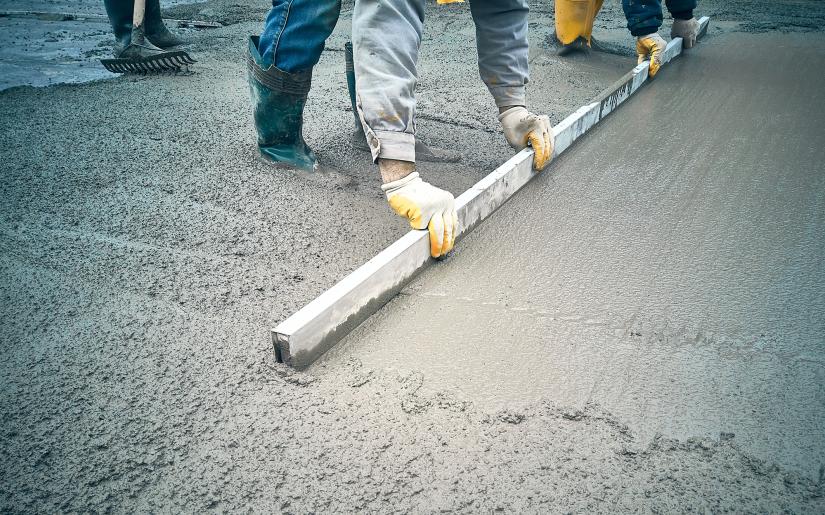In a massive leap for sustainable construction, researchers at the School of Civil and Environmental Engineering at UTS have created concrete that can heal its own cracks.
When cracks begin to emerge in non-conductive concrete, they can be extremely damaging to the overall performance of the concrete.
“This is a huge issue in concrete construction and maintenance,” says Associate Professor Wengui Li, who leads the team in smart concrete infrastructure at the School of Civil and Environmental Engineering in the University of Technology Sydney’s (UTS) Faculty of Engineering and IT.
“Once the concrete has cracks, gas and liquids can penetrate the concrete and contribute to corrosion. Steel reinforcement is often used for concrete, and the steel itself can have corrosion problems. In time the steel often cracks, causing the material to fail. The loading capacity goes down significantly as a result.”
With the aim of finding a solution to this pervasive problem, Dr Wengui and his research team, including Dr Aziz Mahmood, Mr Yipu Guo, and Mr Xuqun Lin at UTS, collaborating with Professor Surendra P. Shah from Northwestern University and Professor Kejin Wang from Iowa State, have spent the past 4-5 years working to develop smart concrete functions. Through their research, they’ve created smart concrete that is self-sensing, self-healing, and hydrophobic.
“There’s big demand in the market right now for these kinds of new smart concrete,” Wengui says. “These innovations will help to build a more sustainable future in construction.”
Developing self-sensing concrete
Concrete is usually non-conductive, but this doesn’t have to be a fixed, unchangeable state.
Wengui and his team within the UTS Faculty of Engineering and IT have managed to transform non-conductive concrete into a conductive substance by adding nano-materials such as nanocarbon tube and graphene oxide to the concrete. This process creates what’s known as ‘self-sensing concrete’.
If cracks emerge in conductive concrete, the electrical conductivity of the concrete will increase dramatically.
“Based on the signal of change in the electric resistivity, we’re able to evaluate the health of the concrete infrastructure and determine if maintenance is required to repair it.
“Self-sensing concrete can make our infrastructure smarter. It makes it easier for us to monitor the infrastructure and our overall asset management.”
Ridding of cracks with self-sensing concrete
When concrete has cracks, its loading capacity will decrease by 30 to 40 per cent. However, if the cracks are healed and repaired, 20 to 30 per cent of this loss in strength can be recovered.
This can be achieved through UTS’s process of creating self-healing concrete.
“Once the concrete has cracks, additional material that was initially added to the concrete before it was laid will react with water and calcium hydroxide – one of the main products of cement hydration to produce calcium carbonate,” Wengui explains.

“This process will generate new materials that will fill the concrete cracks and help the concrete recover its strength.”
For this reaction to occur, the concrete requires moisture. Increased humidity will therefore help the concrete to have this reaction and heal the cracks.
“We don’t need to put much effort into it. That’s a big advantage,” Wengui says. “We just add this material into fresh cement and mix it in. During the later stages, we don’t need to maintain it. That means the cost is relatively low. It’s an efficient and easy process for application in the field.”
Self-healing concrete can significantly extend the service life of the infrastructure.
“We’re able to reduce re-construction, maintenance, and repair costs, and improve the sustainability of the construction industry.
“Because of the extended service life of concrete, we use much less cement. That’s one of the main benefits of smart concrete technology,” says Wengui.
“Hydrophobic concrete is a new type of concrete that possesses the unique property of repelling water. This innovative material is anticipated to enhance the durability and service life of concrete infrastructure, leading to reduced maintenance costs and the need for repairs.”
High-impact research projects
In another significant project being undertaken at UTS, the team is investigating the possibility of crushing solid waste to create concrete.
“We would crush the solid waste into small particles and then use that powder to replace cement partially or even completely. This enables us to reduce the amount of cement used in a concrete mix,” Wengui says.
“This new recycled concrete has comparable strength, and even better durability, than conventional concrete.”
Through its collaboration with construction industry partners, UTS is also developing low-carbon concrete using alternative binders such as waste glass powder and calcined clay. This sustainable product would serve as an alternative to conventional concrete and reduce carbon dioxide emissions involved in cement manufacturing.
“We also have the UTS Tech Lab that started in 2018, which is a dedicated research facility that supports industry-led partnerships. Since that time, we’ve created many new capabilities within the lab. We have a testing room in which we can change the temperature and humidity to simulate the real conditions out in the field. Then we can validate the long-term durability of concrete infrastructure. That enables our tech lab to conduct research on concrete durability.” Wengui says.
With its range of projects in the field of sustainable construction, UTS’s School of Civil and Environmental Engineering is drawing students far and wide who are interested in high-impact research into topics including smart concrete and sustainable construction materials.
“Students have the exposure to a range of projects shaping our world. They can positively impact the future of Australia and beyond in terms of our nations’ sustainable capabilities.”
